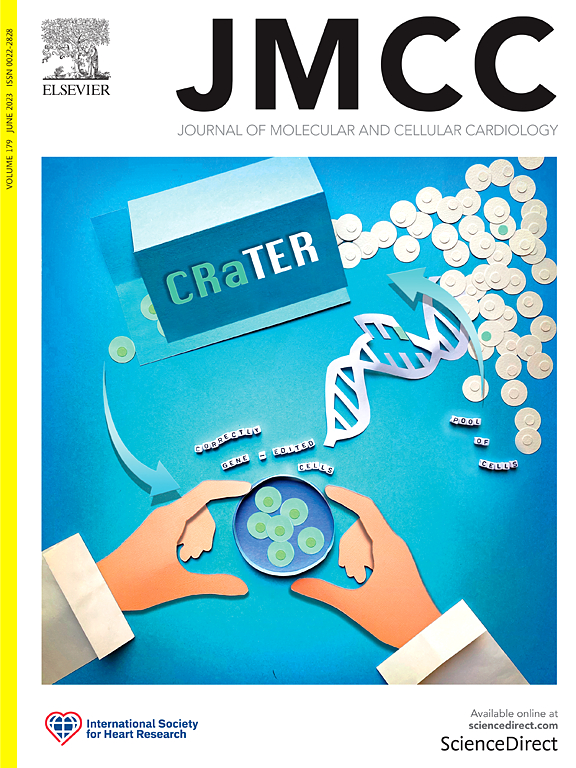创伤后应激障碍小鼠模型对心脏稳态产生负面影响
IF 4.7
2区 医学
Q1 CARDIAC & CARDIOVASCULAR SYSTEMS
引用次数: 0
摘要
创伤后应激障碍(PTSD)是一种致残性心理障碍,其特征是创伤性事件后的侵入性、回避性和过度觉醒的慢性症状。回顾性研究表明,创伤后应激障碍增加心血管疾病(CVD)的风险,包括心律失常、高血压和心肌梗死。本研究的目的是:1)使用提示恐惧条件反射小鼠模型(不可避免足部休克,IFS)开发一种评分方法来区分ptsd样表型,2)使用该模型系统来表征具有极端ptsd样行为的小鼠的心脏表型和功能。我们在2个时间点(ifs后4周和8周)比较3组,对照组,无反应(NR)和ptsd样小鼠的左心室结构和功能。心功能评估显示,在ifs后8周,雄性和雌性ptsd样小鼠均有增加的等容松弛时间,而与对照小鼠相比,只有雌性表现出E/ E′、左房径和射血分数的增加。小天狼星红染色显示雌性ptsd样小鼠间质纤维化增加,纤维化基因Col3a1和Lox表达增加。总的来说,我们的数据表明,表现出与创伤后应激障碍相关的行为特征的小鼠表现出性别依赖性舒张功能障碍,可能是由于,至少部分是由于心脏纤维化的激活。本文章由计算机程序翻译,如有差异,请以英文原文为准。

Mouse model of post-traumatic stress disorder negatively impacts cardiac homeostasis
Post-traumatic stress disorder (PTSD) is a disabling psychological disorder characterized by chronic symptoms of intrusiveness, avoidance, and hyperarousal after a traumatic event. Retrospective studies have indicated PTSD increases the risk for cardiovascular disease (CVD) including arrhythmia, hypertension, and myocardial infarction. The goal of this study was to: 1) use a murine model of cued fear conditioning (inescapable foot shock, IFS) to develop a scoring method to distinguish a PTSD-like phenotype, and 2) use this model system to characterize the cardiac phenotype and function in mice with extreme PTSD-like behaviors. We compared 3 groups, controls, non-responders (NR), and PTSD-like mice at 2 time points [4-weeks and 8-weeks post-IFS] to compare left ventricular structure and function. Assessment of cardiac function showed both male and female PTSD-like mice had increased isovolumetric relaxation time at 8-weeks post-IFS, whereas only females demonstrated increases in E/e’, left atrial diameter, and decreased ejection fraction compared to control mice. Female PTSD-like mice also demonstrated increased interstitial fibrosis through picrosirius red staining and increased expression of fibrotic genes including Col3a1 and Lox. Overall, our data indicated that mice displaying behavioral characteristics associated with PTSD present with sex-dependent diastolic dysfunction likely due, at least in part, to an activation of cardiac fibrosis.
求助全文
通过发布文献求助,成功后即可免费获取论文全文。
去求助
来源期刊
CiteScore
10.70
自引率
0.00%
发文量
171
审稿时长
42 days
期刊介绍:
The Journal of Molecular and Cellular Cardiology publishes work advancing knowledge of the mechanisms responsible for both normal and diseased cardiovascular function. To this end papers are published in all relevant areas. These include (but are not limited to): structural biology; genetics; proteomics; morphology; stem cells; molecular biology; metabolism; biophysics; bioengineering; computational modeling and systems analysis; electrophysiology; pharmacology and physiology. Papers are encouraged with both basic and translational approaches. The journal is directed not only to basic scientists but also to clinical cardiologists who wish to follow the rapidly advancing frontiers of basic knowledge of the heart and circulation.

 求助内容:
求助内容: 应助结果提醒方式:
应助结果提醒方式:


